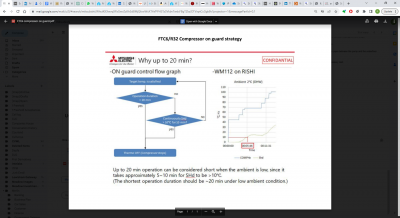Ecodan Minimum Run Time, Flow & COP
We have an 11.2KW Ecodan with an FTC6, installed 2022 with a 300l HW tank and 10 circuits of Wundasmart underfloor heating in around 120 sqm, installer (who was generally great) left every circuit thermostatically controlled.
We spent a lot of time learning about the system over the last year, and one quirk of the Ecodan is a minimum run time which it imposes on itself and the impact on flow temperatures. After conversations with Mitsubishi, this is called the Compressor On Guard Strategy, which enforces a 20 minute minimum runtime, unless the Superheat has been >10C for 10 minutes. It took us a long time to find out from Mitsubishi that this existed.
It doesn't matter a lot what the above means, but the effect - a minimum run time - is interesting. Normally if the pump's minimum heat delivery is higher than the demand, then during low flow conditions (e.g. only a few thermostats calling for heat) the flow temp rises and the pump will turn itself off when flow exceeds 5C above the compensation curve set temperature. In our case, with flow around 27C that might be when flow hits 32C, cunsuming around 1KW of energy.
However the Ecodan will prioritise the importance of keeping on running over halting when exceeding the flow temperature, and will keep trying to heat the water while it keeps running. The compressor runs harder and harder as the temp spirals and we were recording 55C flows at which point it turned off. This incurred very high energy consumption (3KW or more).
This had a huge impact on the COP, dropped below 3 during mild weather. During cold weather it's never a problem, there's always enough flow because so many circuits are calling for heat and minimum runtimes are over 20mins anyway.
We contemplated adding a buffer (cost around £1K installed) but instead trialled removing all thermostatic control in all rooms except the coldest one and using full system volume all the time with the compensation curve driving the system. The result in mild weather is dramatic: we can keep flow temps at 23C above 13C outside, the pump cycles twice an hour with max flow never exceeding 5C above set flow temp, Melcloud-reported COP is regularly over 5 and often over 6, it appears to be phenomenally efficient, borne out by much lower daily energy usage in mild weather.
We do have some small challenges with some warmer rooms getting a couple of degrees C above what we'd prefer but it is cheaper to just live with the extra heat, cost goes up if we re-introduce any thermostatically control rooms, because the volume reduced and pump works harder as above. Our Wundasmart manifolds use automatic balancing valves which set the circuit flow dependant on flow/return temps and can't be manually adjusted down, which is an unfortunate side-effect of an automated system.
The lesson learned is that Ecodans and lots of thermostats really don't work well in mild weather and it's much cheaper (and generally nicer) to go to the effort of working out the right compensation curve and running low flow temps against your full system volume.
Might be useful to anyone with an Ecodan, lots of thermostats and seeing big spikes in flow temps and energy consumption several times an hour during mild weather.
Rod
Posted by: @rodMight be useful to anyone with an Ecodan, lots of thermostats and seeing big spikes in flow temps and energy consumption several times an hour during mild weather.
Rod
Welcome to the forum and thank you for the detailed report. I must admit that I was not aware of the Compressor On Guard Strategy, which I don't believe is mentioned in the manual.
Your findings about thermostats is not only relevant to Ecodan owners, but probably all heat pump owners.
Very interesting. My (14kW) ASHP can definitely run the compressor in bursts of less than 20 minutes when in heating mode. It doesn't do it very often and only when in WC mode and mild conditions. It never heats to more than one or two degrees above WC set point though, although I have only two zones, which means the ASHP is heating at least half my house at any one time. Interestingly, although the compressor stops after less than 20 minutes, I don't think it is ever in heating mode for less than 20 minutes. That is, it spends some time in heating mode while delivering no energy.
This is heating you're talking about btw - the label on the graph on your attachment mentions DHW?
I've never heard of Compressor on guard or Superheat; it's not mentioned on the manuals afaik.
@derek-m if you skim through this Samsung doc, you will see details how a double compressor "heat pump"/AC works, some of this data is pointless to anyone but the engineers that need to look(improve/make a new model) at the machine beyond checking the refrigerant charge.
@kev-m Yes, it's in heating mode. For reasons I still don't understand the HP can spin up to do a DHW cycle when the tank temp is very close to setpoint and cut out immediately the set point is reached without entering the On Guard strategy, even if it's only a couple of mins long. Mitsubishi could not explain why the strategy is used for heating but not for water.
This stuff definitely isn't in the manual and isn't generally known to the support teams, it was only when I pressed them that this appeared.
Thanks fazel, much appreciated.
I suspect that the training manual is for industrial type units, since the smallest compressor of a twin compressor unit is rated at roughly 19kW, and each compressor in the main unit is rated at 25kW. I don't think that it would get planning permission. 😋
Nevertheless the manual appears to give a good description of the inner workings of a heat pump, which is very similar, if not exactly the same, as a domestic sized unit.
- 26 Forums
- 2,417 Topics
- 54.8 K Posts
- 201 Online
- 6,096 Members
Join Us!
Worth Watching
Latest Posts
-
RE: Octopus Cosy 12 Heat Pump Regret: Incredibly Loud, Poor Heating & Constant Hum - Help!
So, after much anguish, and even visiting the neighbour...
By razz , 40 minutes ago
-
MLCP (Multi-Layer Composite Pipe) for ASHP
@editor nope. The info you reported was sufficient for ...
By iotum , 3 hours ago
-
RE: Advice for a novice on Mitsubishi Ecodan 6kW
@robs Quick response while I'm in stationary traffic le...
By Sheriff Fatman , 3 hours ago
-
RE: Setback savings - fact or fiction?
Maths looks right to me, my only question about this ca...
By JamesPa , 4 hours ago
-
RE: Ideal HP290 14kW ASHP - how to optimise
@jamespa I wasn’t offended at all. You are very knowled...
By Davesoa , 4 hours ago
-
RE: Experience - New Build / Complete New Heating System
@vincro I would be surprised if it is much above 5 to 6...
By ASHP-BOBBA , 4 hours ago
-
RE: Recommended home battery inverters + regulatory matters - help requested
Yes, certainly not enough could have been tested in any...
By Batpred , 5 hours ago
-
RE: Post-Traumatic Heat Pump Stress Disorder
Yes bang on and maybe I can illustrate that by way of e...
By iotum , 6 hours ago
-
-

RE: Replacing my 18 month old Hitachi Yutaki ASHP
A big thank you to @jamespa for all his efforts online ...
By trebor12345 , 9 hours ago
-

RE: GSHP WOES! Midland based engineer recommendations?
@editor It is indeed for servicing. My current service ...
By Morgan , 10 hours ago
-
RE: Sunsynk Whole House Backup Issue
Hi @lostandconfused , I agree that topic/thread is the ...
By Batpred , 10 hours ago
-
RE: Speedcomfort radiator fans
In case it helps Andrew Kuhne on openenergy monitor has...
By JamesPa , 11 hours ago
-

Things have gone quiet with you @drei. Any updates?
By Mars , 14 hours ago
-

RE: Passiv Smart Thermostat - Help & Forum Support
Thanks @tim441. Interesting timing, as Passiv are a cur...
By Mars , 16 hours ago
-
Hi everyone, I have a two year old Marlec Solar iBoos...
By Tallmarc , 18 hours ago
-
RE: Please help with the settings ecodan
Are you trying to address any particular performance is...
By Sheriff Fatman , 1 day ago
-
RE: Solis inverters S6-EH1P: pros and cons and battery options
🤣 Well, I never managed to get the HA solis "...
By Batpred , 1 day ago




